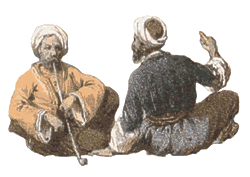The project exhibition “The Holy Land in Tranquility - Scenery of the Regions Surveyed and Depicted by a Multitalented Former Officer from the Netherlands” is run by the research group “Human Mobility and Formation of Plural Societies in the Middle East and the Muslim World”, which is one of the four core projects of ILCAA (Research Institute for Languages and Cultures of Asia and Africa). The exhibition will display thirty-three lithographs, which represent one third of the one hundred lithographs contained in Le Pays d’Israël (The Region of Israel, published in 1857), a rare historical resource held by the ILCAA. These lithographs have been photographed in a high precision digital format, and reproduced in high-definition for visitors to see. The French language annotations for each picture have also been translated.
The materials to be shown at the exhibition are extremely realistic and detailed landscape paintings, and they represent historical pictorial resources of the highest value. Jerusalem is a holy city for Judaism, Christianity, and Islam, which means that it is a holy city for the majority of the world’s population. Around the peripheries of the city are scattered a number of neighborhoods that hold deep meaning for the three Abrahamic religions, and they have attracted many visitors since ancient times. Jerusalem continues to attract the world’s attention today as the stage of the Palestinian Question.
This year is the fiftieth year since ILCAA’s foundation. The ILCAA believes that a great way to mark this significant year would be for visitors to view the state of the region, which links Asia and Africa, 160 years ago, to compare it to the collection of photographs that show the city’s current state, and to reflect upon the religions, politics, people, and cultures of this region.
I am looking forward to hearing all of your thoughts and ideas.
Prof. Yuko Mio
Director of Research Institute for Languages and Cultures of Asia and Africa
Prof. Hidemitsu Kuroki
Core Project Representative

Introduction (Preface by Van de Velde)
This collection of sketches that I have entrusted to the discerning eyes of readers is, as one may see from the title, formed of landscapes that I drew during my travels surveying Palestine from 1851 to 1852. One may read more of my observations and the experiences that left an impression on me in Narrative of a Journey through Syria and Palestine in 1851 and 1852 (2 volumes), which has already been published elsewhere in Dutch, English, and French. In addition, my map (English version: Map of the Holy Land and Geographical Report), which should give an overview of my scientific findings, is now being published on a large scale. Therefore, this collection will serve as a supplement to these works. Accordingly, the order in which the landscapes are shown will conform to the order in which their corresponding locales are introduced in Narrative. I have changed the order only in cases in which I was forced to do so in order to avoid running the risk of overlaps. Regarding the commentaries accompanying these landscapes, I decided to write in the style of a travelogue, so as to offer comprehensive contents to those who do not possess Narrative, and so that those who already know of Narrative may have their interest aroused by the addition of new details.
Out of all the experiences in my travels that left a deep impression on me, there is one in particular that I would sincerely like to share with my readers. In among all the deterioration of Palestine, which was well known among the people, I discovered in desolate areas many scenes of startling natural beauty far away from the main roads and unknown to the common traveler. In these places, the abundant grass itself formed into part of the spectacle of the old ruins it covered, and it spoke of the past glories of the land of Israel and of its future restoration. Such a restoration may only come to pass by the hand of the Everlasting God (Deuteronomy 30: 1–15, Ezekiel 36: 22–38, 37: 12–28).
If interest in Israel’s present situation does not fade and I succeed in drawing people’s attention to the future that God has set in store for this land, I will have achieved what I had hoped for.